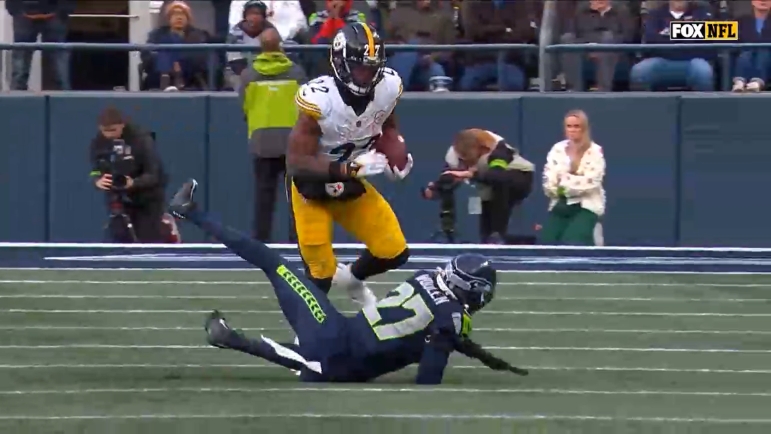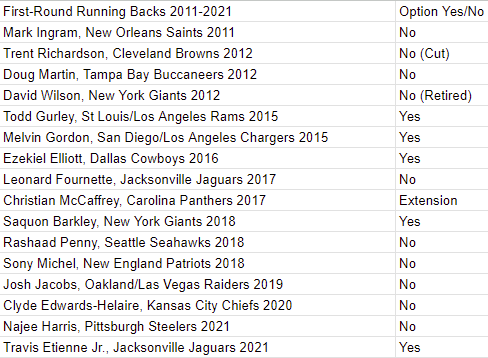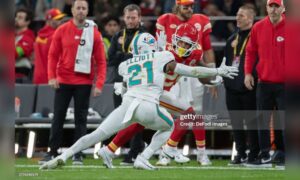Many fans expected the Pittsburgh Steelers to pick up RB Najee Harris’ fifth-year option. After news broke that the team had declined it, all you had to do was look on social media (or Steelers Depot’s comment sections) to see how swiftly fans reacted. Most of those reactions were negative, while a large portion of the media agreed with the Steelers. That included former NFL general manager Mike Tannenbaum, who said that Harris isn’t worth the nearly $7 million price tag.
People can vent their frustrations and argue whether the team made a terrible move. But what do the numbers say? You’ll hear plenty of fans throw around that Harris was the first Steelers running back to run for at least 1,000 yards in his first three seasons. That’s impressive. Does it warrant a fifth-year option, though?
A History Of Running Backs And The Fifth-Year Option
The fifth-year option came into being prior to the 2011 NFL Draft. Starting in 2011, teams have the option of adding a cost-controlled fifth year to their first-round draft pick’s contract. Starting in 2011 and up to the 2021 NFL Draft (the last draft eligible for the fifth-year option so far), there have been 16 running backs drafted in the first round.
Five had their fifth-year options picked up: Todd Gurley, Melvin Gordon, Ezekiel Elliott, Saquon Barkley, and Travis Etienne Jr. Christian McCaffrey was signed to an extension rather than getting his fifth-year option picked up. So six of the 16 first-round running backs were deemed good enough to receive a significant pay raise from the teams that drafted them.
It took until the 2015 draft class before any fifth-year options were exercised. Gurley was drafted by the then-St Louis Rams that season. In two of his first three seasons, he had double-digit rushing touchdowns. He led the league with 13 rushing touchdowns in 2017 (and chipped in six receiving touchdowns). He also averaged over 4.5 yards a carry in two of those seasons.
Gordon was also picked in the first round that year by the then-San Diego Chargers (they moved to Los Angeles after his second season). Gordon failed to find the end zone as a rookie, but he made up for it in his second year. He ran for 10 touchdowns and caught another two. He also averaged over 10 yards a reception. In his third season, he had eight rushing touchdowns and four receiving touchdowns.
Elliott was the third running back to have his fifth-year option picked up. He exploded onto the scene as a rookie for the Dallas Cowboys in 2016, leading the league in both carries and rushing yards. He also had 15 rushing touchdowns that year. He then led the league in carries and rushing yards again in 2018. He did not average below 4.1 yards per carry in his first three seasons in the league.
McCaffrey did not have his fifth-year option picked up by the Carolina Panthers, the team that drafted him in 2017. Instead, McCaffrey signed a four-year extension with the Panthers in 2020. To date, he’s the only first-round running back to receive an actual contract extension. That’s because he has been one of the top running backs in the league from early in his career. His ability as both a runner and a receiver makes him one of the most valuable offensive players in the league. He led the league in yards from scrimmage and combined rushing/receiving touchdowns in 2019.
Saquon Barkley was drafted by the New York Giants in 2018 and won the Offensive Rookie of the Year award. He averaged 5.0 yards a carry and ran for 1,307 yards and 11 touchdowns his rookie season. He also averaged 7.9 yards a reception en route to 721 receiving yards and four receiving touchdowns. He did suffer a season-ending knee injury early in the 2020 season, but his production in his first two seasons was enough for the Giants.
The final first-round running back to have his fifth-year option picked up was Etienne, Harris’ draft-mate. He missed his rookie season with a Lisfranc injury but averaged 5.1 yards a carry and had 11 rushing touchdowns in 2022.
How Does Harris Match Up With These Six Running Backs?

Every running back who had their fifth-year option exercised but one (Gordon) averaged at least five yards every time they touched the ball. Harris averaged 0.1 yards a carry more than Gordon did, but Harris had far and away the lowest yards per reception out of all these running backs. Gordon was tied for the second lowest at 8.2 with Barkley, but Harris was 2.2 yards per catch behind the duo.
Yes, Harris has eclipsed 1,000 yards rushing each of his three seasons in the league. However, he did it at a much less efficient clip than any of these running backs other than Gordon.
But What About The Offensive Line?
Ignoring the lack of consistent playmaking in the passing game for the moment, we know that the Steelers have struggled offensively during Harris’ time in the NFL. So can’t the offensive line be part of the problem with Harris’ yards per carry?
It is absolutely part of it. Yet when you compare Harris with Jaylen Warren over the last two years, one major difference stands out: yards before contact per carry. It’s an advanced statistic that shows how many yards a player gets past the line of scrimmage before a defender contacts them. The offensive line is a big factor in that as well as a running back’s vision and speed.
In 2022, Harris averaged 2.1 yards before contact per carry, a career-high. Warren averaged 3.1, a full yard more. In 2023, Harris’ best year for yards per carry, he dropped down to a career-low 1.6 yards before contact per carry. Warren dropped down too, but he still averaged 2.4.
What Does It All Mean?
When you look at how Najee Harris has performed versus the running backs who have had their fifth-year options picked up, he simply does not match up. His yards per carry is lower than all but one running back. He has far and away the lowest yards per reception of the bunch. Then when you compare how far he gets upfield before a defender makes contact against his teammate, Jaylen Warren, he’s not as good as Warren.
I do not think Harris is a bad running back. He’s been dependable, he works hard, and he’s been available. He’s a physical runner, which shows up in him averaging over two yards after contact a carry in 2021 and 2023. All of those factors are incredibly important.
The problem is that he is not a great running back. He doesn’t have great burst or agility. How often do you see him making a tackler miss in the open field or outrunning defenders?
It is absolutely possible that Harris has a breakout year with new offensive coordinator Arthur Smith and a rebuilt offensive line. Earlier this offseason, I looked into how Smith can help improve the Steelers’ run game. One of the stats that sticks out is that his running backs consistently gain over two yards before contact per carry. If Smith can help make that happen for Harris, he’ll be in line for a big year in Pittsburgh.
That doesn’t mean the Steelers should have picked up his fifth-year option. Based on Harris’ statistical production and lack of explosive athleticism, he’s not in the same category as the majority of the running backs who got their fifth-year option picked up.









